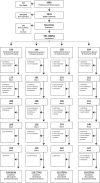A multifaceted workplace intervention for low back pain in nurses' aides: a pragmatic stepped wedge cluster randomised controlled trial
- PMID: 25993549
- PMCID: PMC4617291
- DOI: 10.1097/j.pain.0000000000000234
A multifaceted workplace intervention for low back pain in nurses' aides: a pragmatic stepped wedge cluster randomised controlled trial
Abstract
This study established the effectiveness of a workplace multifaceted intervention consisting of participatory ergonomics, physical training, and cognitive-behavioural training (CBT) for low back pain (LBP). Between November 2012 and May 2014, we conducted a pragmatic stepped wedge cluster randomised controlled trial with 594 workers from eldercare workplaces (nursing homes and home care) randomised to 4 successive time periods, 3 months apart. The intervention lasted 12 weeks and consisted of 19 sessions in total (physical training [12 sessions], CBT [2 sessions], and participatory ergonomics [5 sessions]). Low back pain was the outcome and was measured as days, intensity (worst pain on a 0-10 numeric rank scale), and bothersomeness (days) by monthly text messages. Linear mixed models were used to estimate the intervention effect. Analyses were performed according to intention to treat, including all eligible randomised participants, and were adjusted for baseline values of the outcome. The linear mixed models yielded significant effects on LBP days of -0.8 (95% confidence interval [CI], -1.19 to -0.38), LBP intensity of -0.4 (95% CI, -0.60 to -0.26), and bothersomeness days of -0.5 (95% CI, -0.85 to -0.13) after the intervention compared with the control group. This study shows that a multifaceted intervention consisting of participatory ergonomics, physical training, and CBT can reduce LBP among workers in eldercare. Thus, multifaceted interventions may be relevant for improving LBP in a working population.
Conflict of interest statement
Sponsorships or competing interests that may be relevant to content are disclosed at the end of this article.
Figures


Comment in
-
Primary preventive effects of a multifaceted workplace intervention on low back pain.Pain. 2015 Sep;156(9):1583-1584. doi: 10.1097/j.pain.0000000000000274. Pain. 2015. PMID: 26098440 No abstract available.
References
-
- Dionne CE, Dunn KM, Croft PR, Nachemson AL, Buchbinder R, Walker BF, Wyatt M, Cassidy JD, Rossignol M, Leboeuf-Yde C. A consensus approach toward the standardization of back pain definitions for use in prevalence studies. Spine 2008;33:95. - PubMed
-
- Driessen MT, Proper KI, van Tulder MW, Anema JR, Bongers PM, Van Der Beek AJ. The effectiveness of physical and organisational ergonomic interventions on low back pain and neck pain: a systematic review. Occup Environ Med 2010;67:277–85. - PubMed
Publication types
MeSH terms
LinkOut - more resources
Full Text Sources
Other Literature Sources
Miscellaneous

